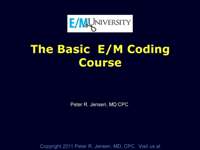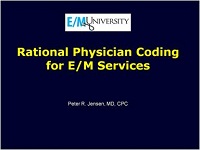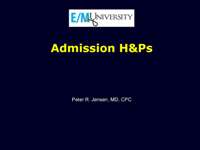How to Read E/m Code + Psychotherapy Note
Introduction and Definitions (1995 and 1997 Due east/M Guidelines)
The purpose of this unabridged website is to provide physicians with the tools they demand to brainwash themselves about E/M coding and documentation. The key principle of E/M Academy is that knowledge is power when it comes to East/M coding and documentation. Too many physicians are chronically undercoding for their services considering they don't understand the rules. A working noesis of the E/M coding is the best way to ensure optimal compliance and avoid inadvertent undercoding. Physicians who understand the idiosyncratic process of E/M documentation can command a higher charge per unit of render on their cerebral labor than their less E/M-savvy counterparts. In other words if you know how to accurately bill for your services, there is a better chance you will get paid for what you actually practise.
E/Thousand stands for "evaluation and management". E/M coding is the process by which doctor-patient encounters are translated into five digit CPT codes to facilitate billing. CPT stands for "current procedural terminology." These are the numeric codes which are submitted to insurers for payment. Every billable procedure has its ain individual CPT code.
The CPT codes which depict physician-patient encounters are often referred to as "Due east/M codes" There are different E/K codes for dissimilar types of encounters such as office visits or hospital visits. Within each blazon of see, at that place are different levels of care. For example, the 99214 code may be used to charge for an part visit with an established patient. There are five levels of care for this type of encounter. The 99214 code is oftentimes called a "level 4" office visit because the lawmaking ends in a "4" and too because information technology is the fourth "level of intendance" for that type of visit (with the 99215 beingness the 5th and highest level of care). Each patient care encounter may be viewed as a unique process which requires specific documentation.
The Key Components of East/M Documentation
The documentation for East/M services is based on three "fundamental" components:
- History
- Physical Exam
- Medical Conclusion-Making
E/M Academy Coding Tip: The key components are used to satisfy the documentation requirements for Due east/M coding UNLESS the doc is coding based on TIME. If time is the controlling cistron, there are no specific documentation requirements for the three key components.
The East/Grand key components tin be thought of every bit the edifice blocks of documentation for all patient encounters. Some types of encounters require complete documentation of all three key components, while others require only two out of iii.
The E/M Guidelines
The documentation requirements for each individual Due east/Grand code are dictated past a set of rules called the E/M guidelines. The Eastward/Chiliad guidelines were developed by the Centre for Medicare and Medicaid Services (CMS) in conjunction with the American Medical Clan. Two versions have been released—the first in 1995 and the last in 1997.
The Complete 1995 and 1997 E/Grand guidelines may be downloaded by clicking here (1995) and here (1997).
For a more detailed discussion about which version may be best for you, click hither.
The E/Yard guidelines define the requirements for private East/One thousand codes based on the extent of the documentation of the iii primal components. In general, higher paying Eastward/K codes (like consultations or initial office visits) require more all-encompassing documentation than lower paying codes (such as office visits with established patients or infirmary progress notes).
E/G Academy Coding Tip:The physician MUST cull to use EITHER the 1995 OR the 1997 E/M guidelines. It is NOT acceptable to mix and match elements from both sets of rules within the torso of the aforementioned note.
E/Grand University Coding Tip: The 1995 and 1997 E/Thousand guidelines are practically identical when it comes to the key components of history and Medical Controlling. The master difference between the 2 versions lies in the documentation required for the physical test (see 1995 Vs. 1997 Due east/One thousand guidelines).
E/M University Coding Tip: Due to increased flexibility for recording the HPI, near physicians should use the 1997 E/M guidelines for encounters where the patient has no spontaneous somatic complaints.
The East/Chiliad guidelines define the requirements for individual East/M codes based on the extent of the documentation of the iii key components. In general, higher paying E/M codes (like consultations or initial function visits) crave more than extensive documentation than lower paying codes (such every bit role visits with established patients or infirmary progress notes). In order to empathize Eastward/K coding, information technology is first necessary to empathize each of the private key components which are explained in our tutorial.
Peter R. Jensen, Medico, CPC
|
The Eastward/Chiliad University Video Tutorials | ||||
| The Bones Course | Rational Physician Coding for East/M Services | Rational Physician Coding for Hospitalist East/M Services | ||
 |  |  | ||
| | | | ||
| This class teaches you lot everything you need to know about the 1995 and 1997 E/Grand guidelines. Learn how to document the history and concrete exam and how to quanitfy your medical decision-making. Y'all are probably over-documenting! | Learn how to select the "correct" level of intendance for every encounter based on the cognitive labor provided. Then perform and document the history and exam in a purpose-driven manner to ensure compliance. | This is the version of the "Rational Md Coding" course designed for hospitalists. See how to quantify your cognitive labor and perform and document the virtually mutual hospitalist encounters as efficiently equally possible. | ||
| Established Office Patients | New Office Patients | Admission H&Ps | ||
 |  |  | ||
| | | | ||
| These are the about common patient encounters on the planet, so it'south important to code correctly for these visits. Knowing the difference betwixt a level iii and level 4 established part patient can make a huge difference in your remibursement and income. | At present that the consult codes accept been eliminated for Medicare patients, the new office patient visit has go the most common outpatient initial encounter. Larn exactly what needs to be documented for each level of treat these visits. All levels of care are discussed. | Footstep-by-step, learn how to perform and document the primal components correctly for all three levels of treat access H&Ps. Y'all will also see how to avert the most common catastrophic documentation errors for these visits. | ||
| Hospital Progress Notes | Due east/Thou Consult Services | Observation Intendance Services | ||
 |  |  | ||
| | | | ||
| These are the most common hospital encounters. Virtually doctors over-certificate and nether-code for these services. This class will show you how to avoid this trap and save time while increasing reimbursement. | Although Medicare no longer pays for consult services, some individual payers still do. Merely beware. Auditors love to downcode these visits when doctors don't include the exact right terminology. Learn to become it right. | The observation rules have recently been changed. Did you know there is a whole new set of codes for ascertainment "progress notes?" Encounter when to use the observation codes and how to complete the documentation correctly. | ||
| Critical Intendance and Other Timed Services | Ascertainment Care Services | The Faculty Grade | ||
 |  |  | ||
| | | | ||
| What is critical intendance? What needs to be documented? What is needed for prolonged services? Using existent-life examples, you will become the answers to these questions and more from this course. | You spend a lot of fourth dimension in the ER so you might every bit well get paid for it. Emergency room visits are not just for ER docs whatever more! Hospitalists now have to utilise these codes when performing "consults" on patients in the ER. | The rules are a picayune different for documenting E/Thousand services while working with medical students, interns and residents. Learn how house staff tin can assist you complete the documentation for academic E/M services. | ||
| The Resident Due east/G Coding Course | ||||
 | ||||
| | ||||
| Well-nigh academic programs provide little if any E/1000 coding education which leaves residents at a disadvantage when they get out in to the real world. This course teaches efficient East/Chiliad coding and documentation from the house-staff point of view. | ||||
Source: https://emuniversity.com/Definitions.html
0 Response to "How to Read E/m Code + Psychotherapy Note"
Post a Comment